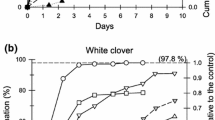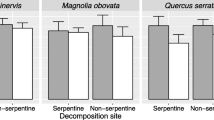Abstract
Laboratory and greenhouse bioassays were used to test for inhibitory effects of senescent and decomposed leaves and aqueous extract from bilberry (Vaccinium myrtillus L.) against seed germination and seedling growth of aspen (Populus tremula L.), birch (Betula pendula Roth.), Scots pine (Pinus sylvestris L.), and Norway spruce [Picea abies (L.) Karst.]. Aqueous extracts from bilberry leaves were inhibitory to aspen seed germination and seedling growth and also induced root damage and growth abnormalities. Addition of activated carbon removed the inhibitory effects of extracts. Senescent leaves reduced pine and spruce seed germination, but rinsing of seeds reversed this inhibition. Senescent leaves were more inhibitory than decomposed leaf litter, suggesting that the inhibitory compounds in bilberry leaves are relatively soluble and released at early stages during decomposition. Spruce was generally less negatively affected by litter and aqueous extracts than the other tested species. This study indicates that chemical effects of bilberry litter have the potential to inhibit tree seedling recruitment, but these effects were not consistently strong. Phytotoxicity is unlikely to be of critical importance in determining success for spruce seedling establishment.
Similar content being viewed by others
References
André, J., Gensac, P., Pellissier, F., andTrosset, L. 1987. Régénération des peuplements d'épicéa en altitude: Recherches préliminaires sur le rôle de l'allélopatie et de la mycorhization dans les premiers stades du développement.Rev. Ecol. Biol. Sol. 24(3):301–310.
Arnborg, T. 1943. Granberget. En växbiologisk undersökning av ett sydlapplänskt granskogsområde med särskild hänsyn till skogstyper och föryngring. Almqvist and Wiksell, Uppsala.
Arnborg, T. 1990. Forest types of northern Sweden.Vegetatio 90:1–13.
Blum, U., andRice, E. L. 1969. Inhibition of symbiotic nitrogen-fixation by gallic and tannic acid, and possible roles in old-field succession.Bull. Torrey Bot. Club 96(5):531–544.
Blum, U., Dalton, B. R., andRawlings, J. O. 1984. Effects of ferulic acid and some of its microbial metabolic products on radicle growth of cucumber.J. Chem. Ecol. 10(8):1169–1191.
Blum, U., Dalton, B. R., andShann, J. R. 1985. Effects of ferulic andp-coumaric acids in nutrient culture of cucumber leaf expansion as influenced by pH.J. Chem. Ecol. 11(11):1567–1582.
Blum, U., Gerig, T. M., andWeed, S. B. 1989. Effects of mixtures of phenolic acids on leaf area expansion of cucumber seedlings grown in different pH Portsmouth A1 soil materials.J. Chem. Ecol. 15(10):2413–2423.
Einhellig, F. A. 1987. Interactions among allelochemicals and other stress factors of the plant environment, pp. 343–357,in G. R. Waller (ed.). Allelochemicals: Role in Agriculture and Forestry. ACS Symposium Series 330. American Chemical Society, Washington, D.C.
Eliasson, L. 1959. Inhibition of the growth of wheat roots in nutrient solutions by substances exuded from the roots.Kungl. Lantbrukshogsk. Ann. 25:285–293.
Gallet, C., andLebreton, P. 1995. Evolution of phenolic patterns in plants and associated litters and humus of a mountain forest ecosystem.Soil Biol. Biochem. 27(2):157–165.
Grime, J. P., andCurtis, A. V. 1976. The interaction of drought and mineral nutrient stress in calcareous grasslands.J. Ecol. 64:975–988.
Grime, J. P., Hodgson, J. G., andHunt, R. 1988. Comparative Plant Ecology. Unwin Hyman, London.
Havas, P., andKubin, E. 1983. Structure, growth and organic matter content in the vegetation of an old growth spruce forest in northern Finland.Ann. Bot. Fenn. 20:115–149.
Kuiters, A. T., andDanneman, C. A. J. 1987. Water soluble phenolic substances in soils under several coniferous and deciduous tree species.Soil Biol. Biochem. 19(6):765–769.
Kuuluvainen, T. 1994. Gap disturbance, ground microtopography, and the regeneration dynamics of boreal coniferous forests in Finland: A review.Ann. Zool. Fenn. 31:35–51.
Kuusela, K. 1990. The Dynamics of Boreal Coniferous Forests. Sitra, Helsinki.
Lehman, M. E., Blum, U., andGerig, T. M. 1994. Simultaneous effects of ferrulic andp-coumaric acids on cucumber leaf expansion in split-root experiments.J. Chem. Ecol. 20:1773–1782.
Lehto, J. 1969. Studies conducted in northern Finland on regeneration of Scots pine by means of the seed tree and shelterwood methods (English summary).Commun. Inst. For. Fenn. 67:4.
Lyu, S. W., Blum, U., Gerig, T. M., andO'Brien, T. E. 1990. Effects of mixtures of phenolic acid on phosphorus uptake by cucumber seedlings.J. Chem. Ecol. 16(8):2559–2567.
Mahall, B. E., andCallaway, R. M. 1992. Root communication mechanisms and intracommunity distributions of two Mojave desert shrubs.Ecology 73(6):2145–2151.
Nilsson, M.-C. 1992. The Mechanisms of Biological Interference byEmpetrum hermaphroditum on Tree Seedling Establishment in Boreal Forest Ecosystem. Dissertation 91-576-4640-6. Swedish University of Agricultural Sciences, Umeå, Sweden.
Nilsson, M.-C. 1994. Separation of allelopathy and resource competition by the boreal dwarf shrubEmpetrum hermaphroditum Hagerup.Oecologia 98:1–7.
Nilsson, M.-C., andZackrisson, O. 1992. Inhibition of Scots pine seedling establishment byEmpetrum hermaphroditum.J. Chem. Ecol. 18:1857–1870.
Pellisier, F. 1993. Allelopathic inhibition of spruce germination.Acta Ecol. 14(2):211–218.
Pellisier, F. 1994. Effects of phenolic compounds in humus on the natural regeneration of spruce.Phytochemistry 36(4):865–867.
Pietikainen, J., andFritze, H. 1995. Clear-cutting and prescribed burning in coniferous forest: Comparison of effects on soil fungal and total microbial biomass, respiration activity and nitrification.Soil Biol. Biochem. 27(1):101–109.
Rasmussen, J. A., andEinhellig, F. A. 1977. Synergistic inhibitory effects ofp-coumaric and ferulic acids on germination and growth of grain sorgum.J. Chem. Ecol. 3:197–205.
Rice, E. L. 1984. Allelopathy. 2nd ed. Academic Press, Orlando, Florida.
Rikala, R., andJozefek, H. J. 1990. Effects of dolomite lime and wood ash on peat substrate and development of tree seedlings.Silvia Fenn. 24(4):323–334.
Schimmel, J. 1993. On Fire: Fire Behavior, Fuel Succession and Vegetation Response to Fire in the Boreal Forest. Dissertation 91-576-4753-4. Swedish University of Agricultural Sciences, Umeå, Sweden.
Sarvas, R. 1950. Investigations into the natural regeneration of selectively cut private forests in northern Finland.Cumm. Inst. For. Fenn. 38:85–95.
Sirén, G. 1955. The development of spruce forest on raw humus sites in northern Finland and its ecology.Acta For. Fenn. 62:1–363.
Tallis, J. H. 1991. Plant Community History. Chapman and Hall, London.
Tirén, L. 1949. Om den naturliga föryngringen på obrända hyggen i norrlänsk granskog.Medd. Statens Skogsforsk. Inst. Stockholm. 38(9):1–172.
Viro, P. J. 1974. Effects of forest fire on soil, pp. 7–45.in T. T. Kozlowski and C. E. Ahlgren (eds.). Fire and Ecosystems. Academic press. New York.
Walter, H., andBreckle, S. W. 1989. Temperate and Polar Zonobiomes of Northern Eurasia. Springer-Verlag. Berlin.
Whitehead, D. C., Hazel, D., andHartley, R. D. 1983. Bound phenolic compounds in water extracts of soils, plant and leaf litter.Soil Biol. Biochem. 15(2):133–136.
Williams, R. D., andHoagland, R. E. 1982. The effects of naturally occurring phenolic compounds on seed germination.Weed Sci. 30:206–212.
Yambe, Y., Hori, Y., andTakeno, K. 1992. Genetic attributes of bracken as revealed by enzyme electrophoresis.Aust. Inst. Agric. Sci. Occas. Publ. 40:71–78.
Zackrisson, O. 1977. Influence of forest fires on the north Swedish boreal forest.Oikos 29:22–32.
Zackrisson, O. 1985. Some evolutionary aspects of life history characteristics of broadleaved tree species found in the boreal forests, pp. 17–36,in B. Hägglund and G. Peterson (eds.). Broadleaves in Boreal Silviculture—An Obstacle or an Asset?, Swedish University of Agricultural Science, Department of Silviculture Report No. 14.
Zackrisson, O., andNilsson, M.-C. 1992. Allelopathic effects byEmpetrum hermaphroditum on seed germination of two boreal tree species.Can. J. For. Res. 22:1310–1319.
Author information
Authors and Affiliations
Rights and permissions
About this article
Cite this article
Jäderlund, A., Zackrisson, O. & Nilsson, MC. Effects of bilberry (Vaccinium myrtillus L.) litter on seed germination and early seedling growth of four boreal tree species. J Chem Ecol 22, 973–986 (1996). https://doi.org/10.1007/BF02029948
Received:
Accepted:
Issue Date:
DOI: https://doi.org/10.1007/BF02029948




